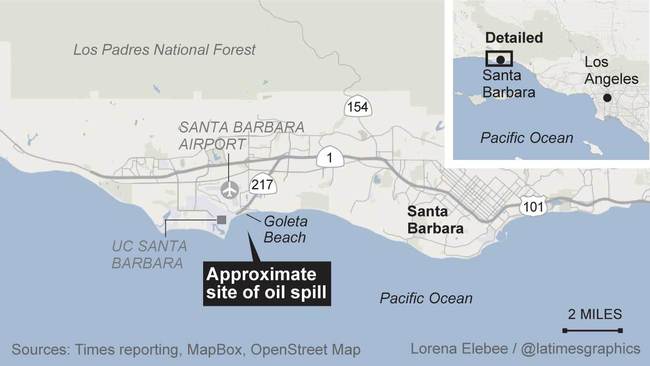Repost from the Los Angeles Times
[Editor: See also ABC News, Coast Guard Says California Oil Slick Will Vanish on Its Own. – RS]
Big oil slick off Santa Barbara County coast sparks new concerns
By Javier Panzar , Joseph Serna, Matt Hamilton, July 29, 2015 10:39pm
That greasy luster returned once again to the waters off Santa Barbara County.
An oil slick that stretched more than 3 miles was spotted Wednesday by some kayakers, about two months after a ruptured pipeline spilled more than 21,000 gallons of crude into the ocean off this picturesque coastline.
The sheen — no thicker than a coat of paint — did not prompt the closure of any beaches, and the U.S. Coast Guard said the oily substance would dissipate on its own.
As Coast Guard investigators awaited lab results that may pinpoint the oil’s source, images of a shiny patch of sea and splotches of tar along these pristine shores sent a quiver of anxiety through a community that’s still recovering from the May 19 spill.
 “I just hoped it wasn’t another oil spill,” said Janine Dorn, a substitute teacher who brought her black poodle, Jack, to survey Goleta Beach before sunset. The oil spill in May had her fuming, she said. “Then I see this and it’s incredible. This can’t be happening again.”
“I just hoped it wasn’t another oil spill,” said Janine Dorn, a substitute teacher who brought her black poodle, Jack, to survey Goleta Beach before sunset. The oil spill in May had her fuming, she said. “Then I see this and it’s incredible. This can’t be happening again.”
Shortly before 11 a.m., the kayakers reported seeing the sheen about 1,000 feet off Goleta Beach, according to the county fire department. A black and brown gooey substance had coated the kayaks and the kayakers’ legs, according to photos from the fire department.
Initially described as measuring 60 feet wide, the sheen by Wednesday evening had stretched 3.5 miles long and half a mile wide, U.S. Coast Guard Lt. Ryan Schmid said. As tides moved, the oil split into sections and covered only about one-third of the total area, he said.
The patch was seen floating near an oil platform owned by Venoco Inc., but the company denied that its platform was involved. That platform, known as Holly, was shut down in May, a company official said. Its pipeline was flushed of any oil and refilled with seawater.
The Coast Guard, meanwhile, said the sheen could have been an ordinary, natural seepage. At Coal Oil Point, a seep field in the Santa Barbara Channel, thousands of gallons of oil flow into the ocean each day, something residents have grown accustomed to.
“The earth burps all the time,” said Robert Hernandez, an electrician who fishes nearly every day off the Goleta pier. “You smell it, you get a little on you. No big deal.”
Hernandez, 60, said he has been fishing along the Central Coast since he was 15. Sheens such as those spotted Wednesday are part of life in a region where the petroleum-rich sea bed regularly emits oil and natural gas, he said, which made him question why it was newsworthy. “It cracks me up,” he said. “At first I thought there was a shark attack or something.”
Yet environmental activist Rebecca Claassen, an organizer with Food and Water Watch, said it’s too early to minimize the sheen as a natural occurrence, saying the oil platforms that dot the county’s coastline pose a daily risk. “We can see a spill any day as long as there is drilling off shore,” she said.
Federal officials said Wednesday’s sheen also could be a remnant of this spring’s spill, when the corroded pipe operated by Plains All American Pipeline leaked an estimated 101,000 gallons of crude along the Gaviota coast and forced a weeks-long closure of Refugio State Beach.
The director of the state’s Department of Fish and Wildlife, Charlton Bonham, said Wednesday that the cleanup of the Refugio spill is ongoing, with about 14,000 gallons of oily water removed from the ocean.
Cleanup crews have responded to reports of tar balls as far away as Orange County, and one tar ball recovered in Manhattan Beach had the same oil “DNA” as the oil spilled at Refugio, he said.
Appearing in Sacramento before the state Ocean Protection Council, Bonham said the natural seepage in the area is challenging how his agency assesses the effectiveness of recovery efforts. “What is clean?” he told the panel. “How clean is clean?”
As federal and state investigators await the results of laboratory tests from Wednesday’s incident, Santa Barbara County’s director of public health, Dr. Takashi Wada, said there is no immediate risk to swimmers, and the county’s beaches and fishing piers remain open.
After swimming in the water off Goleta Beach with her friend, Anya Schmitz, 16, opined that the water was crystal clear — perfect for a summer dip.
“Conditions are great,” she said. “Seems like a lot of hype to me.”
Panzar reported from Goleta; Serna and Hamilton from Los Angeles. Times staff writer Phil Willon in Sacramento contributed to this report.

